Timeline of the 1997 Pacific hurricane season

The 1997 Pacific hurricane season was the most active season since the 1994 season, producing 24 tropical depressions, 19 of which became tropical storms or hurricanes. The season officially started on May 15, 1997 in the Eastern Pacific—designated as the area east of 140°W—and on June 1, 1997 in the Central Pacific, which is between the International Date Line and 140°W. The season officially ended in both basins on November 30, 1997. These dates typically limit the period of each year when most tropical cyclones form in the eastern Pacific basin. This timeline documents all the storm formations, strengthening, weakening, landfalls, extratropical transitions, as well as dissipation. The timeline also includes information which was not operationally released, meaning that information from post-storm reviews by the National Hurricane Center, such as information on a storm that was not operationally warned on, has been included.
The first storm formed on June 1 and the final storm crossed into the western Pacific on December 6, thus ending the season. There were 24 cyclones in both the eastern and central Pacific, including 5 unnamed tropical depressions. Of these, 19 were in the east Pacific; 8 peaked at tropical storm intensity, while 10 reached hurricane status. Seven of these reached Category 3 intensity or higher on the Saffir–Simpson Hurricane Scale, including central Pacific cyclones Super Typhoons Oliwa and Paka, which became typhoons after crossing into the Western Pacific.
Activity in the Central Pacific was above average; two tropical storms formed in addition to several tropical depressions. Some of the storms entered the region from the east. The 1997 season was the fourth-most active in the Central Pacific since satellite observations began. Nine tropical cyclones entered or formed in the region during that period.[1]
Timeline of storms

May
- May 15
- The Eastern Pacific hurricane season officially begins.[2]
June
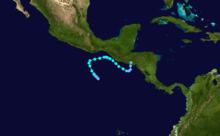
- June 1
- The Central Pacific hurricane season officially begins.[2]
- 0000 UTC – Tropical Depression One-E forms 300 miles (555 km) south of the Gulf of Tehuantepec.[3]
- June 2
- 1200 UTC – Tropical Depression One-E strengthens into Tropical Storm Andres.[3]
- June 6
- 0600 UTC – Tropical Storm Andres weakens into a tropical depression.[3]
- June 7
- 0100 UTC – Tropical Depression Andres makes landfall near San Salvador, El Salvador with wind of 30 mph (50 km/h).[3]
- 0600 UTC – The surface circulation of Tropical Depression Andres rapidly dissipates over the mountains of Central America.[3]
- June 9
- 1800 UTC – Tropical Depression Two-E forms in the Gulf of Tehuantepec.[4]
- June 10
- 0000 UTC – Tropical Depression Two-E strengthens into Tropical Storm Blanca.[4]
- June 12
- June 21
- 1800 UTC – Tropical Depression Three-E forms.[5]
- June 24
- 0000 UTC – Tropical Depression Three-E dissipates.[5]

- June 25
- 0600 UTC – Tropical Depression Four-E forms 450 miles (830 km) southeast of the southern tip of the Baja Peninsula.[6]
- 1800 UTC – Tropical Depression Four-E strengthens into Tropical Storm Carlos.[6]
- June 27
- 0600 UTC – Tropical Storm Carlos weakens into Tropical Depression Carlos.[6]
- June 28
- 0600 UTC – Tropical Depression Carlos dissipates.[6]
- June 29
- 1200 UTC – Tropical Depression Five-E forms.[7]
July
- July 4
- 0600 UTC – Tropical Depression Five-E dissipates.[7]
- July 5
- 1200 UTC – It is estimated that Tropical Depression Six-E forms 600 miles (1110 km) southeast of the southern tip of the Baja Peninsula it is operationally upgraded to Tropical Storm Dolores.[8]
- July 6
- 0000 UTC – Tropical Depression Six-E strengthens into Tropical Storm Dolores.[8]
- July 7
- 1200 UTC – Tropical Storm Dolores strengthens into the first hurricane of the season.[8]
- July 10
- 0600 UTC – Hurricane Dolores weakens into Tropical Storm Dolores.[8]
- July 11
- 0600 UTC – Tropical Storm Dolores weakens into a tropical depression.[8]
- July 12
- 0600 UTC – Tropical Depression Seven-E forms 850 miles (1575 km) south-southwest of the southern tip of the Baja Peninsula.[9]
- 1800 UTC – Tropical Depression Seven-E strengthens into Tropical Storm Enrique.[9]
- 1800 UTC – Tropical Depression Dolores dissipates.[8]

- July 13
- 1200 UTC – Tropical Storm Enrique strengthens into the second hurricane of the season.[9]
- July 14
- 0000 UTC – Hurricane Enrique strengthens into a Category 2 hurricane.[9]
- 1200 UTC – Tropical Depression Eight-E forms several hundred miles south of Manzanillo, Mexico.[10]
- 1800 UTC – Hurricane Enrique strengthens into the first major hurricane (a hurricane with winds more than 111 mph (180 km/h) of the season.[9]
- July 15
- July 16
- July 17
- 0600 UTC – Tropical Storm Felicia strengthens into the third hurricane of the season.[10]
- July 18
- July 19
- 0600 UTC – Hurricane Felicia strengthens into a Category 4 hurricane.[10]
- July 20
- July 21
- July 22
- July 27
- 0000 UTC – Tropical Depression One-C forms southwest of the Hawaiian Islands.[11]
- 1800 UTC – Tropical Depression One-C dissipates.[11]
- July 30
- 1200 UTC – Tropical Depression Nine-E forms 300 miles (555 km) south of Salina Cruz, Mexico.[12]
- July 31
- 0600 UTC – Tropical Depression Nine-E strengthens into Tropical Storm Guillermo.[12]
August
- August 1
- 1800 UTC – Tropical Storm Guillermo strengthens into the fourth hurricane of the season.[12]
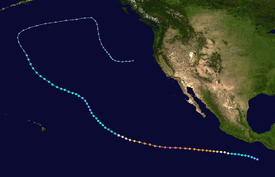
- August 2
- August 3
- 0000 UTC – Hurricane Guillermo strengthens into a Category 4 hurricane.[12]
- August 4
- 1800 UTC – Hurricane Guillermo strengthens into the first Category 5 hurricane of the season.[12]
- August 5
- 1800 UTC – Hurricane Guillermo weakens into a Category 4 hurricane.[12]
- August 6
- 1800 UTC – Hurricane Guillermo weakens into a Category 3 hurricane[12]
- August 7
- August 8
- 0600 UTC – Hurricane Guillermo weakens into a tropical storm.[12]
- August 10
- 0000 UTC – Tropical Depression Ten-E forms 920 miles (1700 km) south-southwest of the southern tip of the Baja Peninsula.[13]
- 1800 UTC – Tropical Storm Guillermo weakens into a tropical depression.[12]
- August 11
- August 14
- 0600 UTC – Tropical Storm Hilda weakens into a tropical depression.[13]
- August 15
- August 16
- 0000 UTC – Tropical Depression Guillermo becomes extratropical.[12]
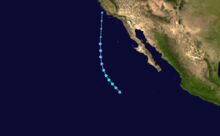
- August 17
- 0000 UTC – Tropical Depression Eleven-E forms 450 miles (830 km) southwest of Cabo San Lucas, Mexico.[14]
- 1200 UTC – Tropical Depression Eleven-E strengthens into Tropical Storm Ignacio.[14]
- August 18
- 0600 UTC – Tropical Storm Ignacio weakens into Tropical Depression Ignacio.[14]
- August 19
- 1200 UTC – Tropical Depression Ignacio becomes extratropical.[14]
- August 25
- 1200 UTC – Tropical Depression Twelve-E forms.[15]
- August 26
- 0000 UTC – Tropical Depression Twelve-E strengthens into Tropical Storm Jimena.[15]
- August 27
- August 29
- August 30
- 0000 UTC – Tropical Depression Jimena dissipates.[15]
September

- September 2
- 1800 UTC – Tropical Depression Two-C forms near the International Dateline.[16]
- September 3
- 0000 UTC – Tropical Depression Two-C strengthens into Tropical Storm Oliwa—the Hawaiian name for Oliver.[16]
- 1800 UTC – Tropical Depression Thirteen-E forms 325 miles (600 km) south-southwest of the southern tip of the Baja Peninsula.[17]
- September 4
- 0000 UTC – Tropical Storm Oliwa moves past 140°W into the West Pacific and the last advisory is issued by the Central Pacific Hurricane Center.[16]
- 0600 UTC – Tropical Depression Thirteen-E strengthens into Tropical Storm Kevin.[17]
- September 6
- 0600 UTC – Tropical Storm Kevin weakens into a tropical depression.[17]
- September 7
- 0600 UTC – Tropical Depression Kevin dissipates.[17]
- September 9
- 1200 UTC – Tropical Depression Fourteen-E forms 400 miles (740 km) south of Manzanillo, Mexico.[18]
- September 10
- 0000 UTC – Tropical Depression Fourteen-E strengthens into Tropical Storm Linda.[18]

- September 11
- September 12
- 0000 UTC – Hurricane Linda strengthens into the second, and final Category 5 hurricane of the season.[18]
- 0600 UTC – Hurricane Linda's pressure drops to 902 mbar (hPa) or 26.64 in and 185 mph (300 km/h) making it the strongest storm in the Northeast Pacific ocean on record.[18]
- 1800 UTC – Tropical Depression Fifteen-E forms 1300 miles (2400 km) east-southeast of the Hawaiian Islands.[19]
- September 13
- 1800 UTC – Hurricane Linda weakens into a Category 4 hurricane.[18]

- September 14
- September 15
- September 16
- September 17
- 0600 UTC – Tropical Storm Linda weakens into a tropical depression.[18]
- September 18
- September 19
- 1200 UTC – Hurricane Nora weakens into a Category 1 hurricane.[20]
- September 21
- September 23
- September 25
- 0630 UTC – Hurricane Nora makes landfall near Punta Eugenia, Mexico on the Baja Peninsula with winds of 85 mph (135 km/h).[20]
- 1100 UTC – Hurricane Nora makes its final landfall near San Fernando, Mexico with winds of 80 mph (130 km/h).[20]
- 1800 UTC – Hurricane Nora weakens into a tropical storm.[20]
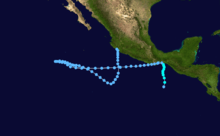
- September 26
- 0000 UTC – Tropical Storm Nora rapidly dissipates into a tropical depression.[20]
- 0600 UTC – The final advisory for dissipating Tropical Depression Nora is issued.[20]
- 1200 UTC – Tropical Depression Seventeen-E forms 300 miles (555 km) south of the Gulf of Tehuantepec.[21]
- 1800 UTC – Tropical Depression Seventeen-E strengthens into Tropical Storm Olaf.[21]
- September 29
- 0000 UTC – Tropical Storm Olaf weakens into a tropical depression and makes landfall near Salina Cruz, Mexico with winds of 35 mph (55 km/h).[21]
October
- October 5
- 1200 UTC – Tropical Depression Eighteen-E forms 200 miles (370 km) south of Puerto Angel, Mexico.[22]

- October 6
- 0600 UTC – Tropical Depression Eighteen-E strengthens into Tropical Storm Pauline.[22]
- 1200 UTC – Tropical Depression Three-C forms southeast of the Hawaiian Islands.[23]
- October 7
- 0000 UTC – Tropical Storm Pauline strengthens into the eighth hurricane of the season.[22]
- 0600 UTC – Hurricane Pauline strengthens into the seventh and final major hurricane of the season.[22]
- 1200 UTC – Hurricane Pauline strengthens into a Category 4 hurricane.[22]
- 1200 UTC – Tropical Depression Three-C dissipates.[23]
- 1800 UTC – Hurricane Pauline weakens into a Category 3 hurricane.[22]
- October 8
- 1800 UTC – Hurricane Pauline regains Category 4 hurricane status.[22]
- October 9
- October 10
- October 12
- 1800 UTC – Tropical Depression Olaf makes landfall near Manzanillo, Mexico with winds of 30 mph (50 km/h) and dissipates.[21]
- October 31
- 0600 UTC – Tropical Depression Four-C forms southeast of the Hawaiian Islands.[24]
November
- November 1
- 0600 UTC – Tropical Depression Four-C dissipates.[24]
- November 7
- 0000 UTC – Tropical Depression Nineteen-E forms 500 miles (925 km) south-southwest of Acapulco, Mexico.[25]
- November 8
- 1200 UTC – Tropical Depression Nineteen-E strengthens into Tropical Storm Rick.[25]
- November 9
- November 10
- 0100 UTC – Hurricane Rick makes landfall near Puerto Escondido, Mexico with winds of 85 mph (135 km/h).[25]
- 1200 UTC – Hurricane Rick weakens into a tropical storm.[25]
- 1800 UTC – Tropical Storm Rick weakens into a tropical depression.[25]
- November 11
- 0000 UTC – Tropical Depression Rick dissipates.[25]
- November 30
- The 1997 central and eastern Pacific hurricane seasons officially end.[2]
December
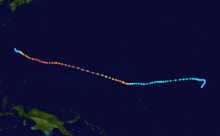
- December 2
- 1200 UTC – Tropical Depression Five-C forms out of season near the Line Islands.[26]
- 1800 UTC – Tropical Depression Five-C strengthens into Tropical Storm Paka, the Hawaiian name for Pat.[26]
- December 7
- 0000 UTC – Tropical Storm Paka crosses the International Date Line into the Western Pacific and the final advisory is issued, therefore ending the 1997 Pacific hurricane season.[26]
See also
References
- ↑ Benjamin C. Hablutzel; Hans E. Rosendal; James C. Weyman & Jonathan D. Hoag. "The 1997 Central Pacific Tropical Cyclone Season". Central Pacific Hurricane Center. Retrieved 2005-10-24.
- 1 2 3 Atlantic Oceanographic and Meteorological Laboratory, Hurricane Research Division. "Frequently Asked Questions: When is hurricane season?". National Oceanic and Atmospheric Administration. Retrieved 2008-10-22.
- 1 2 3 4 5 Rappaport, Richard N. (June 18, 1997). "Tropical Cyclone Report: Tropical Storm Andres". National Hurricane Center. Retrieved 2008-12-26.
- 1 2 3 4 Avila, Lixion A. (June 19, 1997). "Tropical Cyclone Report: Tropical Storm Blanca". National Hurricane Center. Retrieved 2008-12-26.
- 1 2 Lawrence, Miles B. (June 24, 1997). "Tropical Cyclone Report: Tropical Depression Three-E". National Hurricane Center. Retrieved 2008-12-26.
- 1 2 3 4 Mayfield, Max (August 10, 1997). "Tropical Cyclone Report:Tropical Storm Carlos". National Hurricane Center. Retrieved 2008-12-26.
- 1 2 Pasch, Richard J. (July 7, 1997). "Tropical Cyclone Report: Tropical Depression Five-E". National Hurricane Center. Retrieved 2008-12-26.
- 1 2 3 4 5 6 Rappaport, Edward N. (August 19, 1997). "Tropical Cyclone Report: Hurricane Dolores". National Hurricane Center. Retrieved 2008-12-26.
- 1 2 3 4 5 6 7 8 9 10 Avila, Lixion A. (August 15, 1997). "Tropical Cyclone Report:Hurricane Enrique". National Hurricane Center. Retrieved 2008-12-26.
- 1 2 3 4 5 6 7 8 9 10 11 12 Lawrence, Miles B. (August 23, 1997). "Tropical Cyclone Report: Hurricane Felicia". National Hurricane Center. Retrieved 2008-12-27.
- 1 2 "Tropical Cyclone Report: Tropical Depression One-C". Central Pacific Hurricane Center. Retrieved 2008-12-27.
- 1 2 3 4 5 6 7 8 9 10 11 12 13 14 15 16 Mayfield, Max (October 2, 1997). "Tropical Cyclone Report: Hurricane Guillermo". National Hurricane Center. Retrieved 2008-12-27.
- 1 2 3 4 Pasch, Richard J. (December 12, 1997). "Tropical Cyclone Report: Tropical Storm Hilda". National Hurricane Center. Retrieved 2008-12-27.
- 1 2 3 4 Rappaport, Edward N. (August 27, 1997). "Tropical Cyclone Report:Tropical Storm Ignacio". National Hurricane Center. Retrieved 2008-12-27.
- 1 2 3 4 5 6 7 8 9 Avila, Lixion A. (September 16, 1997). "Tropical Cyclone Report: Hurricane Jimena". National Hurricane Center. Retrieved 2008-12-28.
- 1 2 3 "Tropical Cyclone Report: Tropical Storm Oliwa". Central Pacific Hurricane Center. Retrieved 2008-12-28.
- 1 2 3 4 Lawrence, Miles B. (November 4, 1997). "Tropical Cyclone Report: Tropical Storm Kevin". National Hurricane Center. Retrieved 2008-12-28.
- 1 2 3 4 5 6 7 8 9 10 11 12 13 14 Mayfield, Max (October 25, 1997). "Tropical Cyclone Report: Hurricane Linda". National Hurricane Center. Retrieved 2008-12-28.
- 1 2 3 4 Pasch, Richard J. (December 12, 1997). "Tropical Cyclone Report: Tropical Storm Marty". National Hurricane Center. Retrieved 2008-12-29.
- 1 2 3 4 5 6 7 8 9 10 11 12 13 14 15 Rappaport, Edward N. (October 30, 1997). "Tropical Cyclone Report: Hurricane Nora". National Hurricane Center. Retrieved 2008-12-29.
- 1 2 3 4 Avila, Lixion A. (November 5, 1997). "Tropical Cyclone Report: Tropical Storm Olaf". National Hurricane Center. Retrieved 2008-12-29.
- 1 2 3 4 5 6 7 8 9 10 11 12 Lawrence, Miles B. (November 7, 1997). "Tropical Cyclone Report: Hurricane Pauline". National Hurricane Center. Retrieved 2008-12-29.
- 1 2 "Tropical Cyclone Report: Tropical Depression Three-C". Central Pacific Hurricane Center. Retrieved 2008-12-29.
- 1 2 "Tropical Cyclone Report: Tropical Depression Four-C". Central Pacific Hurricane Center. Retrieved 2008-12-29.
- 1 2 3 4 5 6 7 8 9 Mayfield, Max (November 23, 1997). "Tropical Cyclone Report: Hurricane Rick". National Hurricane Center. Retrieved 2008-12-29.
- 1 2 3 "Tropical Cyclone Report: Tropical Storm/Super Typhoon Paka". Central Pacific Hurricane Center. Retrieved 2008-12-29.
